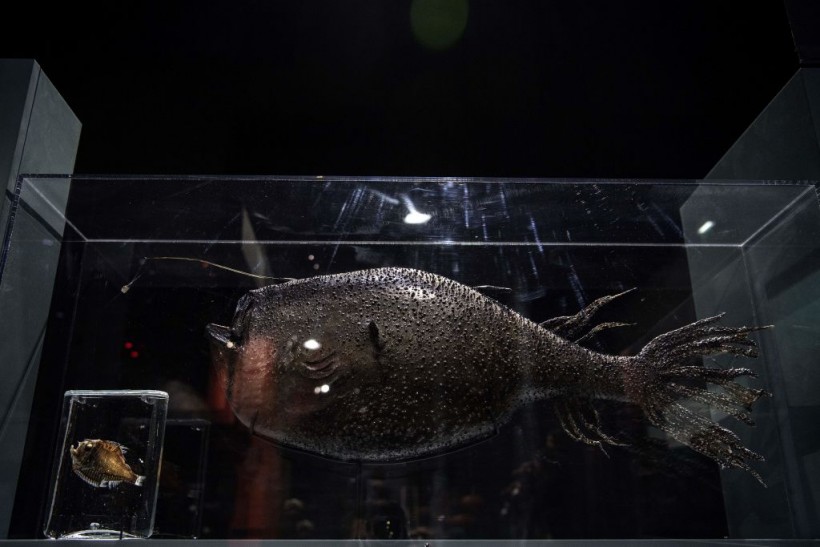Scientists from the Museums Victoria Research Institute introduce new bizarre yet wonderful deep-sea creatures living near deep-sea volcanoes in the Indian Ocean. During their 6,800-mile (11,000-km) expedition to the deep sea, they came face-to-face with a blind eel with gelatinous skin and sharp teeth called hermaphrodite lizard fish and other weird out-of-this-world aquatic animals.
Dr. Tim O'Hara, the expedition's Chief Scientist, said they discovered many deep-sea fishes that are potentially living in the remote marine park. They believe that Parks Australia will use their maps, data, and images to manage marine life in the future.

A deep-sea anglerfish were displayed for the 'Ocean' exhibition at the National Museum of Natural History (Museum d'Histoire Naturelle) in Paris on March 29, 2019.
Australian Marine Park Mapped for the First Time
The research expedition to Australia's Cocos Islands Marine Park enabled researchers to map the park in detail for the first time to reveal a plethora of rare, deep-sea creatures. According to YourWeather.co.uk, the Marine Park is Australia's marine national park that covers an area of 467,054 sq. km. in the rich, turquoise waters of the Indian Ocean.
The team conducted a 35-day journey through the marine park onboard the research vessel operated by the Commonwealth Scientific and Industrial Research Organisation (CSIRO), named Investigator. The team also captured footage and specimens of some fascinating marine life aside from underwater topography.
Cocos Islands Marine Park was established in March 2022 as one of the 60 Australian marine parks that make up one of the world's largest marine parks.
The mysterious underwater topography of the park was shown using a 3D imaging device that was beamed directly from the vessel to the residents of Cocos Islands so they could admire the underwater world beneath them. Images show that there are flat-topped sea mountains, volcanic cones, and massive canyons formed from the avalanche of sand.
Nelson Kuna, a hydrographic surveyor from CSIRO, noted that the dataset covers a substantial area of the new marine park and shows Cocos Islands as the twin peaks of a mountain that rises 5,000 meters from the surrounding seafloor.
Bizarre Deep-Sea Creatures in Cocos Islands
The research project started in 2021 and was intended to help the Australian government manage and protect the area after establishing it as a marine park earlier this year, MailOnline reported. They found that giant volcanoes from 50 and 140 million years ago were formed by seamounts that gradually sank into the seafloor.
Over time, it was covered by fossils of different sea creatures compressed into limestones. The flat-topped sea mountains have become the habitat of various sea organisms. Researchers took photos and specimens of some of these deep-sea creatures to study and show them to other people.
Some sea creatures include the blind eel covered in loose, transparent skin called the Pelican Eel, which has a massive and expandable stomach capable of devouring large food items.
"Scientists surveying the ocean floor near Christmas I. & Cocos Islands have uncovered a number of incredible deep-sea creatures that have never been seen before."
— David Lamar (@david_lamar) November 16, 2022
Unfortunately, many of the "never seen before" creatures were killed "for science".
Link: https://t.co/tBpWmEbWVz pic.twitter.com/Yk49TduYfj
Another is the Tribute Spiderfish that stands on its stilt-like lower fins to reach its mouth to catch small prawns drifting by. Also, they found a Highfin Lizard fish with an ovotestis with both male and female functional reproductive organs. They found other deep-sea creatures: Sloane's Viperfish, Slender Snipe Eel, and Pancake sea urchins.
RELATED ARTICLE: Top 5 World's Most Bizarre Deep Sea Creatures That Baffled the Scientists, One Is Possibly the Ugliest
Check out more news and information on Deep-Sea Creatures in Science Times.














